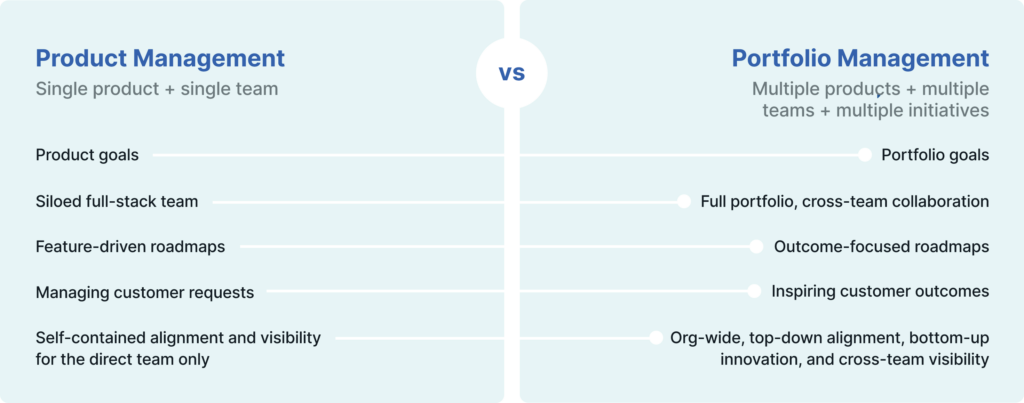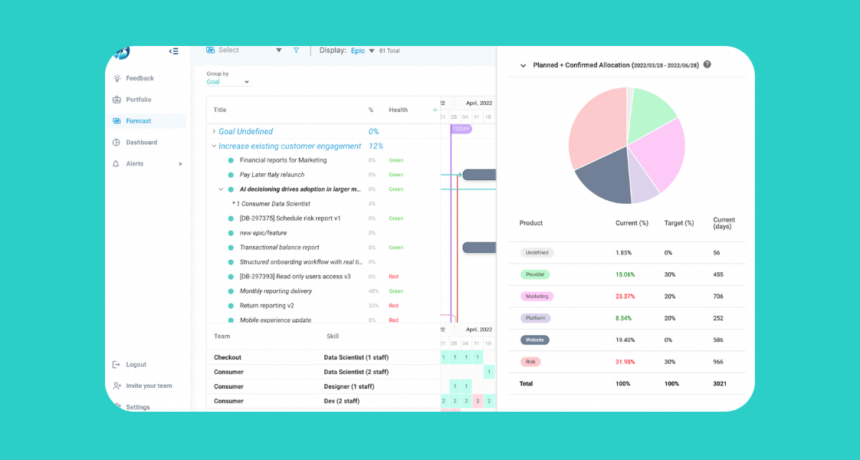Executive Summary
Every product leader, especially the Chief Product Officer (CPO), manages a portfolio or multiple portfolios. One of the most important deciding factors for the success of a portfolio is allocation and outcome-based re-allocation, just like how investment professionals emphasize portfolio allocation more than choosing individual investments. When managing a product portfolio, proper resource planning and allocation is critical. Modern organizations are changing from feature-based planning to outcome-based product practices. CPOs are making this switch while:
- Effectively leading a balanced portfolio to achieve both long-term vision and near-term results
- Assessing the entire product portfolio through different lenses
- Setting target allocations by various swimlanes or bets
- Reviewing planned allocation and making adjustments in real-time
Responsive Product Portfolio Management (Responsive PPM) is the framework CPOs use to accomplish the above. Responsive PPM dynamically connects objectives, customer needs, products, and resources with execution. It accelerates outcomes responsive to the state of the organization and the market.
Unlike traditional project portfolio management, which focuses on a group of projects and centralized governance, Responsive PPM focuses on continuously evolving products. This allows portfolio leaders to adapt and adjust in real-time to deliver customer delight while driving business outcomes.
This post covers the common questions about product resource planning and its relation to portfolio management:
- What is product resource planning and portfolio allocation?
- Why is resource planning important?
- Who is involved with portfolio resource planning?
- How does product management and portfolio management work together?
- How does Responsive Product Portfolio Management benefit product leaders?
What Is Product Resource Planning and Portfolio Allocation?
Traditional resource planning allocates tasks to teams based on their capacity and skills. It maximizes efficiency by keeping projects on budget and the work on track by monitoring progress. However, the digital world demands a new approach to delivering and improving industry-leading products. Why? Because we live in an agile, ever-changing landscape that requires outcomes that move businesses forward.
Instead of viewing work as individual projects, Product Resource Planning takes a holistic view. It assesses where teams should focus across the entire portfolio to meet company goals.
Portfolio Allocation:
- Enables companies to maximize portfolio outcomes
- Empowers “what-if” analysis for better roadmap trade-off decisions
- Responsively adjusts and re-allocates to the area that makes the most significant impact toward key objectives
Why Is Resource Planning Important?
Product Resource Planning ensures teams are focused on the right areas of the business. It drives transparency and helps teams aggregate data on the demand and supply of their people, skills, technologies, and resources. Rather than everyone working on what they think is essential, resource planning provides a holistic view so leaders can understand what they’re saying “yes” and “no” to.
Without resource planning, there is no alignment with strategic objectives and no framework to rank projects based on helping the business reach its goals.
Managing a smooth resource planning process doesn’t have to be a manual task using spreadsheets. Some of the most successful teams use a product portfolio resourcing tool to help them:
- Identify areas of over-allocation
- Report on where teams are spending their time
- Review dependencies or resource bottlenecks
- Visualize and compare what-if scenarios

Who Is Involved With Portfolio Resource Planning?
Any function required to build and deliver products gets involved with portfolio resource planning. Championing the process and keeping the core planning team aligned is one of the primary responsibilities of a Chief Product Officer. In addition, they also provide other leaders and stakeholders outside the resource group with visibility into portfolio performance, which is directly related to how they handle resource planning and portfolio allocation.
CPOs collaborate with leaders from the following areas to make data-driven roadmaps that keep resources on track and product line efforts aligned with business strategies:
- Development for programming work
- Marketing for positioning and messaging
- Sales for pricing, demos, and closing
- Customer success for continued adoption and cross-sell opportunities
- Finance for budgeting and optimizing margins
By partnering with business leaders and functional managers for resource planning, CPOs balance multiple dimensions, including customer needs, business goals, and engineering resources—which are the ultimate drivers in deciding how a company should spend its time and money.
How Does Product Management And Portfolio Management Work Together?
At this point, you may wonder, “How does the discipline of product management fit into everything we’ve been talking about?”
Furthermore, you may wonder, “How does portfolio management relate to product resource planning and allocation?”
Product management focuses on solving problems and sparking innovation at the customer level. In parallel with these efforts, portfolio management takes a broader view to ensure strategic alignment and resource allocation needs are met to maximize portfolio outcomes.
Traditional product management skills include analyzing customer needs, discovering product opportunities, guiding product design, and managing feature roadmaps.
Portfolio management skills include strategic planning, allocation with trade-off analysis, forecasting, scenario planning, and making real-time adjustments.

“Portfolio management skills or a portfolio mindset is a key element for every strategic product manager.”
Wyatt Jenkins, Chief Product Officer at Procore (watch the full webinar on YouTube)
Every day, product managers find themselves managing complexity and delivering the best product outcomes given a multitude of constraints. This is exactly why product managers already have the skills to apply a portfolio approach to their work.
How Does Responsive Product Portfolio Management Benefit Product Leaders?
After managing more than 10 million hours of portfolio roadmaps from PayPal, Shutterfly, Bigcommerce, and other fast-growing startups and interviewing product and technology executives from leading innovative companies such as Netflix, Amazon, and Shopify, Becky Flint (CEO of Dragonboat) designed “Responsive Product Portfolio Management” to help companies of any size deliver outcomes.
Responsive PPM replaces fixed-scope projects with a portfolio containing outcome-focused initiatives that connect with objectives. These objectives iteratively get built, tested, and validated before the next iteration.
Responsive PPM also creates a bottom-up workflow that empowers teams and CPO leaders to make holistic decisions toward achieving their OKRs (Objectives and Key Results). These decisions should align with the long-term strategy and quarterly milestones.
Product leaders can better adjust and reprioritize using Responsive PPM in response to the changes in:
- Execution
- Available resources
- External factors
As a more holistic evaluation tool, resource teams use Metrics over Available Resources (MoAR) over ROI. Looking beyond dollar-based costs and benefits provides product leaders with measurable values to plan for near-term outcomes.
The entire Responsive PPM process is continuous regardless of organizational level. Executives, leaders, and teams must assess and adjust for the next month, quarter, and year. Responsive PPM is the rallying drumbeat for an organization to move quickly and efficiently.
Conclusion
Is your planning process ready for an upgrade?
Consider using Responsive Product Portfolio Management to guide the way. It will help you:
- Set multi-dimensional portfolio allocation
- Take a broader view to evaluate product requests
- Gain visibility into whether your roadmap is on track, providing the flexibility to make real-time adjustments
- Use release planning to look at your estimates, resources, and dependencies
- Connect with Agile tools to predict progress and start taking responsive action
- Deliver personalized stakeholder reports
- Use OKRs to close the loop across allocation, ideation, prioritization, planning, execution, and reporting
Now is the time to elevate your resource planning and portfolio allocation framework. Don’t wait. Start building product roadmaps that accelerate portfolio outcomes.
PS: CPOs from Shopify, Pendo, Procore, and more share their insights during The CPO Series.




